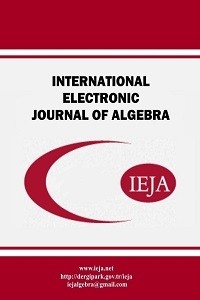FULL HEAPS AND REPRESENTATIONS OF AFFINE WEYL GROUPS
FULL HEAPS AND REPRESENTATIONS OF AFFINE WEYL GROUPS
We use the author’s combinatorial theory of full heaps to categorify the action of a large class of Weyl groups on their root systems, and thus to give an elementary and uniform construction of a family of faithful permutation representations of Weyl groups. Examples include the standard representations of affine Weyl groups as permutations of Z and geometrical examples such as the realization of the Weyl group of type E6 as permutations of 27 lines on a cubic surface; in the latter case, we also show how to recover the incidence relations between the lines from the structure of the heap. Another class of examples involves the action of certain Weyl groups on sets of pairs (t, f), where t ∈ Z and f is a function from a suitably chosen set to the two-element set {+, −}. Each of the permutation representations corresponds to a module for a Kac-Moody algebra, and gives an explicit basis for it.
Keywords:
affine Weyl groups, heaps of pieces, 27 lines on a cubic surface, permutation representations, root systems Kac-Moody algebras,
___
- R. B´edard, Cells for two Coxeter groups, Comm. Algebra, 14 (1986), 1253–
- A. Bj¨orner and F. Brenti, Affine permutations of type A, Electron. J. Combin. (1996), research paper 18.
- A. Bj¨orner and F. Brenti, Combinatorics of Coxeter Groups, Springer, New York, 2005.
- P. Cellini, P. M¨oseneder Frajria and P. Papi, The c W -orbit of ρ, Kostant’s formula for powers of the Euler product and affine Weyl groups as permutations of Z, J. Pure Appl. Algebra, 208 (2007), 1103–1119.
- H.S.M. Coxeter, The polytope 2 whose twenty-seven vertices correspond to the lines to the general cubic surface, Amer. J. Math. 62 (1940), 457–486.
- H. Eriksson, Computational and combinatorial aspects of Coxeter groups, Ph.D. thesis, KTH, Stockholm, Sweden, 1994.
- R.M. Green, Full heaps and representations of affine Kac–Moody algebras, Int. Electron. J. Algebra 2 (2007), 138–188.
- R. Hartshorne, Algebraic Geometry, Springer-Verlag, New York, 1977.
- J.E. Humphreys, Reflection Groups and Coxeter Groups, Cambridge Univer- sity Press, Cambridge, 1990.
- V.G. Kac, Infinite dimensional Lie algebras (third edition), Cambridge Uni- versity Press, Cambridge, UK, 1990.
- M. Kashiwara, On crystal bases of the q-analogue of universal enveloping al- gebras, Duke Math. J. 63 (1991), 465–516.
- G. Lusztig, Some examples of square integrable representations of semisimple p-adic groups, Trans. Amer. Math. Soc. 277 (1983), 623–653.
- L. Manivel, Configurations of lines and models of Lie algebras, J. Algebra 304 (2006), 457–486.
- N. Perrin, Small resolutions of minuscule Schubert varieties, preprint; math.AG/0601117.
- J.Y. Shi, The Kazhdan–Lusztig cells in certain affine Weyl groups, Lecture Notes in Mathematics, 1179, Springer, Berlin, 1986.
- J.Y. Shi, The verification of a conjecture on left cells of certain Coxeter groups, Hiroshima Math. J. 24 (1994), 627–646.
- R.P. Stanley, Enumerative Combinatorics, Volume 1, Cambridge University Press, Cambridge, UK, 1997.
- J.R. Stembridge, Minuscule elements of Weyl groups, J. Algebra, 235 (2001), –743.
- G.X. Viennot, Heaps of pieces, I: basic definitions and combinatorial lemmas, Combinatoire ´Enum´erative, ed. G. Labelle and P. Leroux, Springer-Verlag, Berlin, 1986, pp. 321–350.
- N.J. Wildberger, A combinatorial construction for simply-laced Lie algebras, Adv. Appl. Math. 30 (2003), 385–396.
- N.J. Wildberger, A combinatorial construction of G, J. Lie Theory 13 (2003), –165. R.M. Green
- Department of Mathematics, University of Colorado Campus Box 395 Boulder, CO 80309-0395 USA
- E-mail: rmg@euclid.colorado.edu
- ISSN: 1306-6048
- Yayın Aralığı: Yılda 2 Sayı
- Başlangıç: 2007
- Yayıncı: Abdullah HARMANCI
